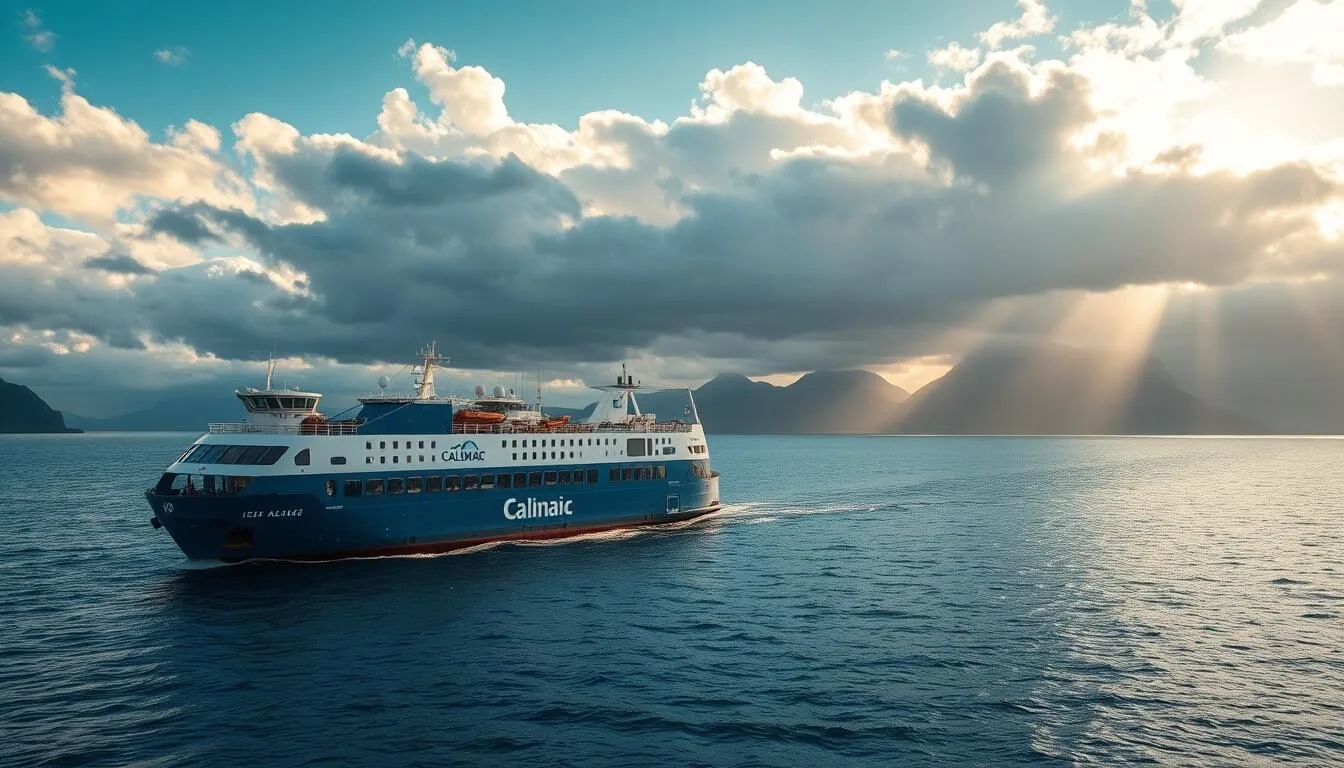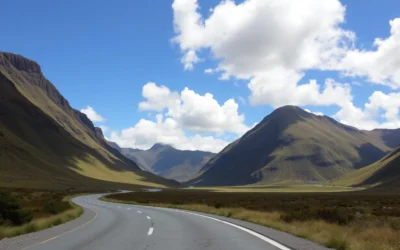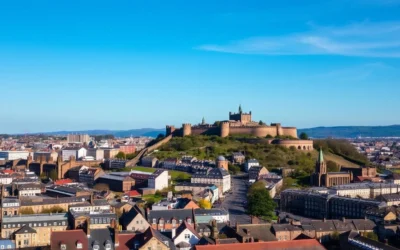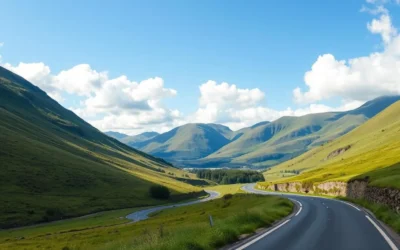✓ Accommodations✓ Flights✓ Rental Cars
The Outer Hebrides boast more ancient stone structures per square mile than anywhere else in Europe, with the 5,000-year-old Callanish Standing Stones predating even the Egyptian pyramids. This remote island chain off Scotland’s northwest coast offers travelers a unique blend of prehistoric wonders, breathtaking landscapes, and rich Gaelic culture that feels worlds away from mainland life. From dazzling white-sand beaches that rival the Caribbean to ancient blackhouse villages where time stands still, these islands promise unforgettable experiences for those willing to make the journey.
Getting to the Outer Hebrides
CalMac ferry service provides the main transportation link to the Outer Hebrides
The most common way to reach the Outer Hebrides is by ferry with CalMac Ferries. The main routes include Ullapool to Stornoway (Isle of Lewis), Uig (Skye) to Tarbert (Harris) or Lochmaddy (North Uist), and Oban to Castlebay (Barra). The journey itself is part of the adventure, with opportunities to spot dolphins, whales, and sea eagles along the way.
If you prefer flying, Loganair operates regular flights from Glasgow, Edinburgh, and Inverness to Stornoway on Lewis. For a truly unique arrival, consider flying to Barra, where planes land directly on the beach at Traigh Mhor – the only scheduled beach landing in the world!
Ready to explore the Outer Hebrides?
Find the best flight deals to Scotland and start your island adventure today.
Best Time to Visit the Outer Hebrides
The Outer Hebrides enjoy a milder climate than you might expect thanks to the Gulf Stream, but weather can be unpredictable year-round. For the best experience, visit between May and September when days are longest and temperatures most pleasant. June offers up to 18 hours of daylight, perfect for maximizing exploration time.

Summer evenings bring spectacular light to Luskentyre Beach on Harris
July and August are peak tourist season, offering the warmest weather but also the largest crowds and highest prices. May and September provide an excellent balance of decent weather and fewer visitors. If you’re interested in wildlife, spring brings nesting seabirds, while autumn offers chances to spot migrating birds and even the Northern Lights on clear nights.
Sunday Observance: Be aware that Sundays are still widely observed as a day of rest on Lewis and Harris. Many businesses, attractions, and transportation services are closed or operate on limited schedules. Plan accordingly by stocking up on supplies and arranging activities for Sundays in advance.
Getting Around the Outer Hebrides
The Outer Hebrides stretch over 130 miles from Lewis in the north to Barra in the south. Having your own transportation provides the greatest flexibility for exploring these beautiful islands at your own pace.
Car Rental and Driving
Renting a car is the most convenient option for exploring the islands thoroughly. You can bring your own vehicle on the ferry (book well in advance during summer) or rent locally from companies like Car Hire Hebrides in Stornoway.
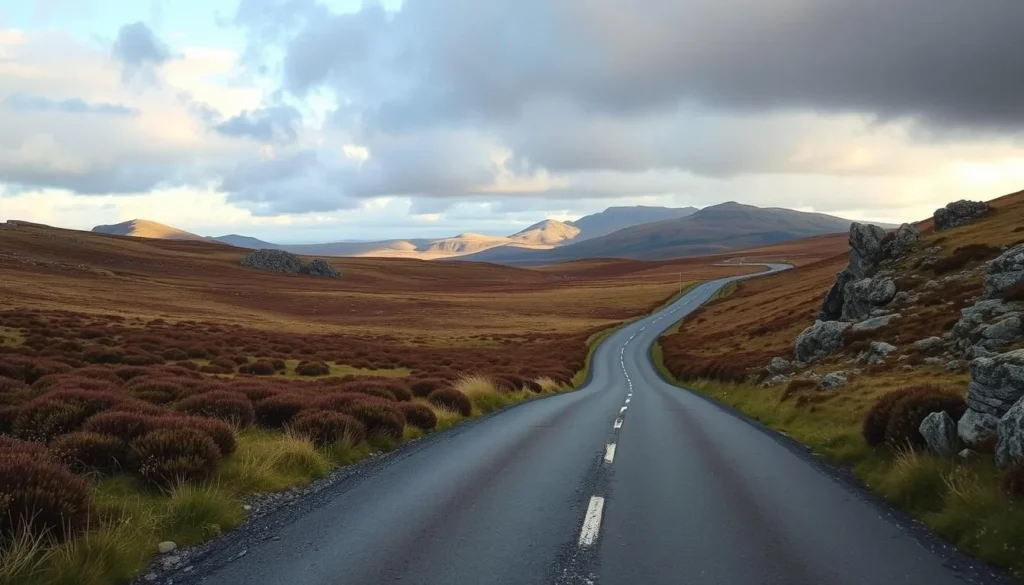
Single-track roads with passing places are common throughout the islands
Single-Track Road Etiquette:
- Use passing places to let oncoming vehicles pass
- If a passing place is on your left, stop there
- If it’s on your right, stop opposite it
- Wave to thank drivers who give way to you
- Never park in passing places
Public Transportation
Bus services connect the main towns and villages on each island, operated by Comhairle nan Eilean Siar. While serviceable for reaching major attractions, schedules can be limited, especially on weekends.
Cycling
The Outer Hebrides are part of the Hebridean Way, a 185-mile cycling route spanning 10 islands. With relatively flat terrain and light traffic, cycling is an excellent way to experience the landscapes up close. Bicycle rentals are available in Stornoway and other main towns.
Explore at your own pace
Rent a car and discover hidden gems throughout the Outer Hebrides.
Where to Stay in the Outer Hebrides
Accommodation options in the Outer Hebrides range from traditional B&Bs and guesthouses to self-catering cottages and boutique hotels. During peak season (June-August), booking well in advance is essential as quality options are limited and fill quickly.
Stornoway
The largest town offers the widest selection of hotels, restaurants, and amenities. Perfect as a base for exploring Lewis.
Harris
Stay near Tarbert for access to both north and south Harris, or choose accommodations near Luskentyre for beach proximity.
Uists & Barra
More remote with fewer options but offering authentic island experiences in small communities.
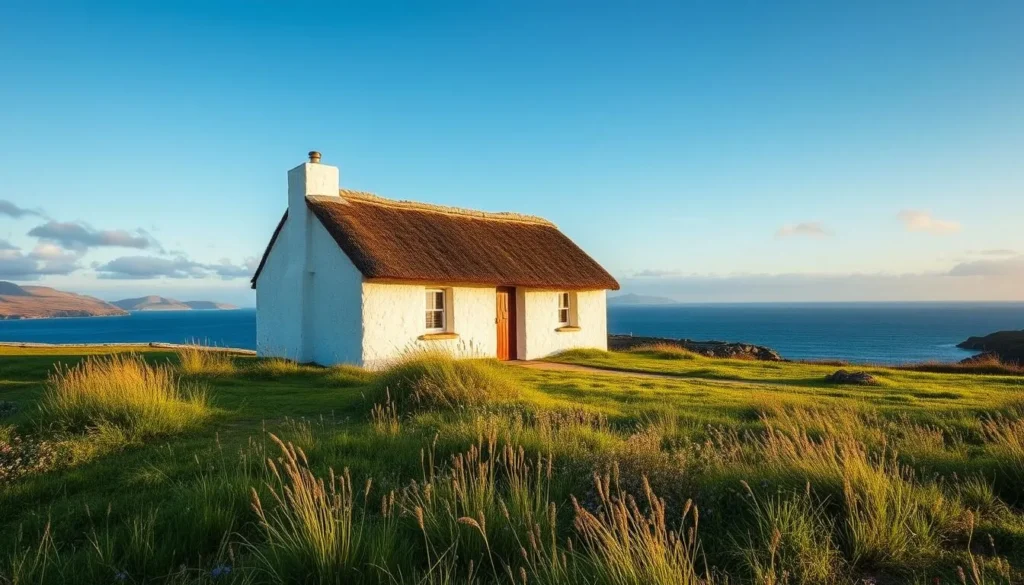
Traditional cottages offer authentic accommodation experiences throughout the islands
Unique Stays
For a truly memorable experience, consider staying in a restored blackhouse at Gearrannan Blackhouse Village on Lewis or booking a luxury self-catering cottage with panoramic ocean views on Harris. Camping and glamping options are also available for those seeking closer connection with nature.
Find your perfect island accommodation
From traditional blackhouses to seaside cottages, book your stay today.
Top Things to Do on the Isle of Lewis
Callanish Standing Stones (Calanais)
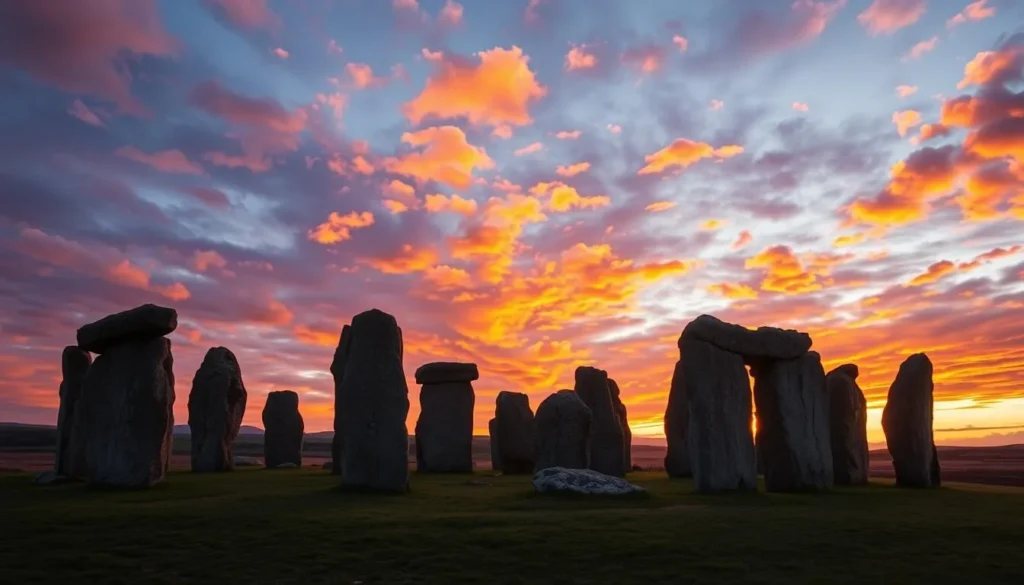
The mysterious Callanish Standing Stones date back nearly 5,000 years
The crown jewel of Outer Hebrides attractions, the Callanish Standing Stones are older than Stonehenge and create a mysterious cross-shaped pattern with a central stone circle. Dating back to around 3000 BC, their exact purpose remains unknown, though theories suggest astronomical observations or religious ceremonies. Visit the excellent visitor center to learn about the stones’ history and significance before exploring the site. For a magical experience, come at sunrise or sunset when the light creates dramatic shadows and fewer visitors are present.
Gearrannan Blackhouse Village
Step back in time at this restored village of traditional blackhouses, where families lived alongside their livestock until the 1970s. Now serving as both museum and accommodation, the village offers a fascinating glimpse into traditional Hebridean life. Watch demonstrations of Harris Tweed weaving, experience the warmth of a peat fire, and learn about the challenging yet resilient lifestyle of islanders past. The museum house remains furnished as it would have been, complete with box beds and traditional implements.
Lews Castle and Museum nan Eilean
This Victorian-era castle in Stornoway houses the excellent Museum nan Eilean, home to six of the famous Lewis Chessmen – 12th-century chess pieces carved from walrus ivory and discovered in Uig in 1831. The museum’s interactive exhibits explore the islands’ natural and cultural heritage. After visiting the museum, stroll through the castle’s beautiful grounds and woodland walks.
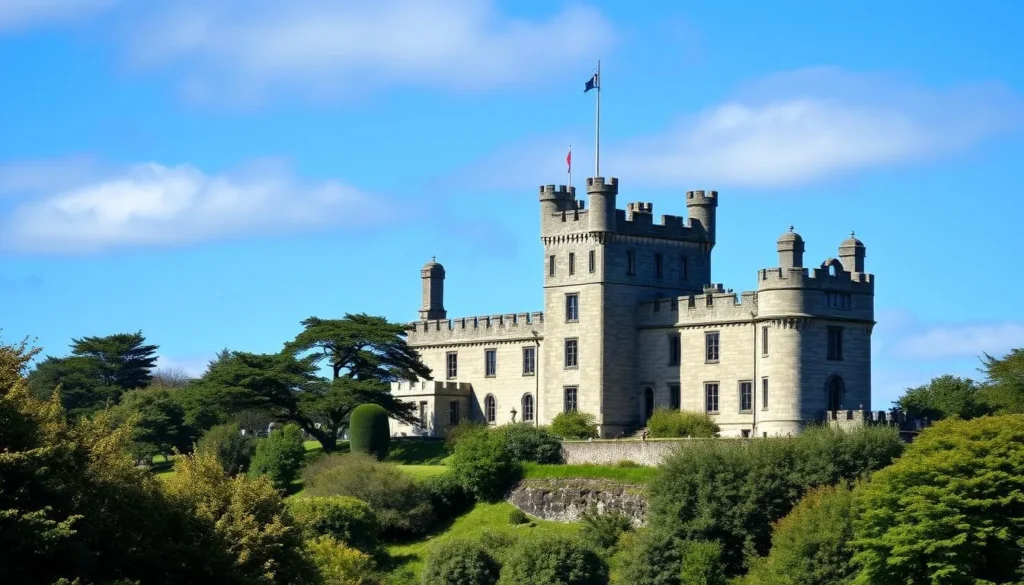
Lews Castle overlooks Stornoway harbor and houses the Museum nan Eilean
Dun Carloway Broch
One of Scotland’s best-preserved Iron Age brochs (stone roundhouses), Dun Carloway dates back around 2,000 years. These impressive structures served as defensive homes for local chieftains. Climb the ancient staircase built within the double walls and imagine life in this remote outpost centuries ago. The panoramic views from the broch’s hillside location are worth the visit alone.
Butt of Lewis Lighthouse
At the northernmost tip of Lewis stands this impressive red-brick lighthouse, built in 1862 and never painted. The surrounding cliffs and rock formations are spectacular, especially during stormy weather when massive waves crash against the rocks. The Guinness Book of Records once listed this spot as the windiest place in Britain, so hold onto your hat!
Experience Lewis’s ancient wonders
Book a guided tour to learn about the fascinating history and culture of these islands.
Browse Guided Tours
Must-See Places on the Isle of Harris
Luskentyre Beach
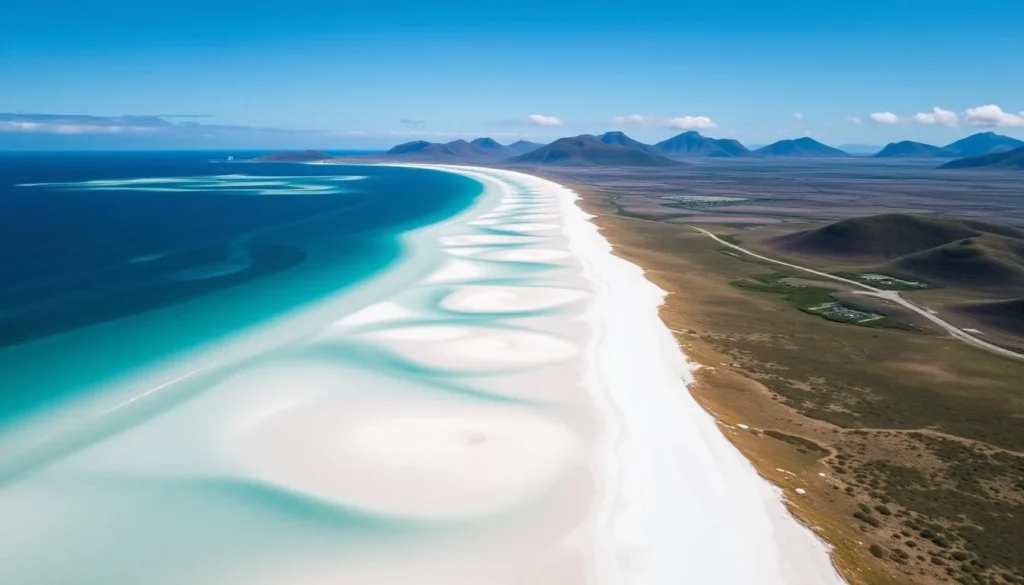
Luskentyre Beach regularly ranks among the world’s most beautiful beaches
Consistently ranked among the UK’s best beaches, Luskentyre’s vast expanse of pristine white sand and crystal-clear turquoise waters could easily be mistaken for a tropical paradise. The backdrop of mountains and constantly shifting light creates a mesmerizing landscape that photographers will adore. Even on cooler days, the beach’s beauty makes it worth a visit – just bring layers as the Atlantic breeze can be brisk!
Scarista Beach
Another stunning beach on Harris’s west coast, Scarista offers miles of golden sand, rolling dunes, and powerful Atlantic waves that attract surfers. Less visited than Luskentyre, it’s perfect for those seeking solitude and uninterrupted walks along the shore. The beach takes on a pinkish hue when wet, creating a magical atmosphere, especially at sunset.
Harris Tweed
Harris Tweed is the only fabric in the world protected by its own Act of Parliament, requiring it to be handwoven by islanders in their homes using pure virgin wool dyed and spun in the Outer Hebrides. Visit the Harris Tweed Hebrides showroom in Tarbert to see weavers at work and purchase authentic products directly from the source. The distinctive fabric makes for high-quality, long-lasting souvenirs and gifts.
Isle of Harris Distillery
Known as “The Social Distillery,” this relatively new establishment in Tarbert produces the award-winning Isle of Harris Gin, infused with local sugar kelp seaweed for a distinctive maritime flavor. While their whisky matures, the gin has gained international acclaim. Take a tour to learn about the distillation process and the company’s community-focused ethos, then sample their products in the stylish tasting room.
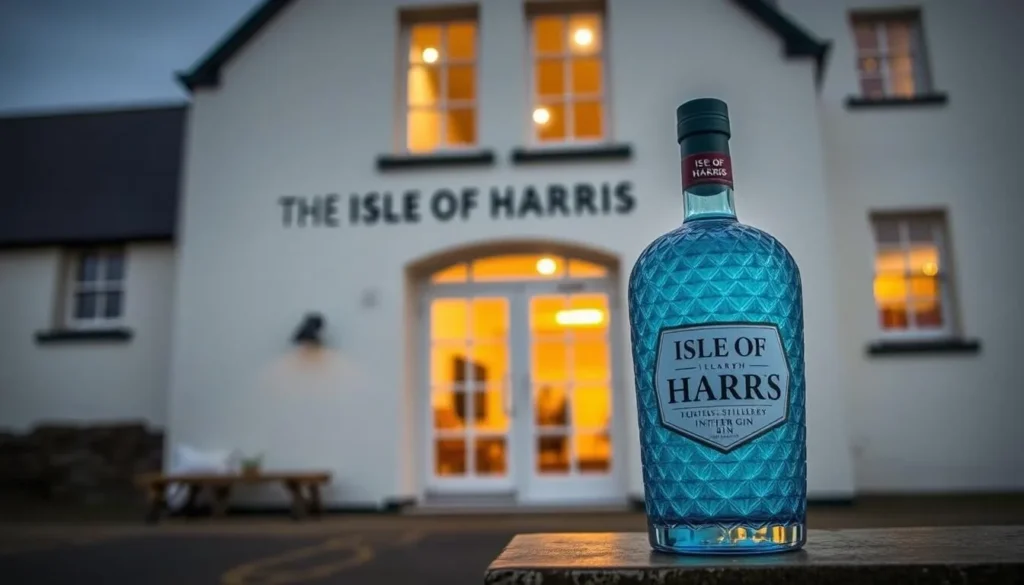
The Isle of Harris Distillery produces award-winning gin with local botanicals
The Golden Road
This winding single-track road along Harris’s east coast earned its name not from gold deposits but from the enormous expense of building it through the rocky, “moonlike” terrain. The stark, rocky landscape contrasts dramatically with the lush west coast and offers numerous hidden coves, craft studios, and spectacular viewpoints. Take your time driving this route, stopping frequently to appreciate the otherworldly scenery.
Exploring the Uists and Barra
The southern islands of the Outer Hebrides chain offer a more remote experience with unique attractions of their own.
Barra Airport Beach Landing
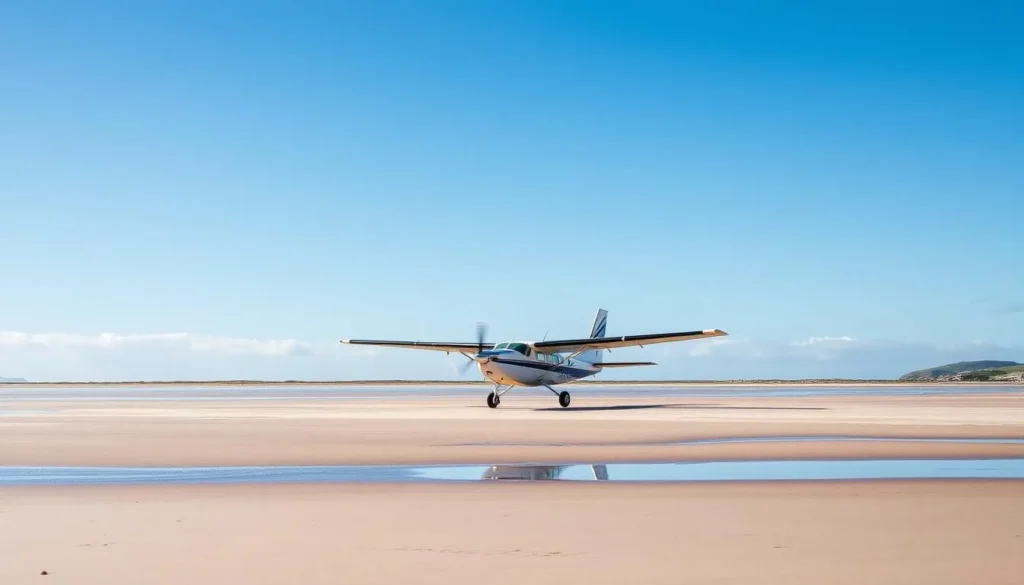
Barra Airport is the only commercial airport in the world where scheduled flights land on a beach
Witness a truly unique aviation experience at Barra Airport, the only commercial airport in the world where scheduled flights land on a beach. Flight times vary with the tides, as the beach serves as the runway. Even if you’re not flying, watching the small Twin Otter planes land and take off on Traigh Mhor (Big Beach) is an unforgettable sight. The airport café offers excellent views of the action.
Kisimul Castle
Known as the “Castle in the Sea,” this small medieval fortress sits on a rocky islet in Castlebay, Barra. Dating from the 15th century, it was the ancestral home of the Clan MacNeil. Take a short boat ride from the pier to explore the castle’s interior, including the great hall, chapel, and watchtower, which offer panoramic views of the bay.
North Uist Beaches and Wildlife
North Uist is renowned for its beautiful beaches and abundant wildlife. The western coastline features a string of stunning white sand beaches, while the east coast’s sheltered inlets and lochs attract diverse birdlife. Visit the RSPB reserve at Balranald to spot corncrakes, lapwings, and other rare species. The island’s unique “machair” ecosystem – fertile low-lying grassy plains – bursts with wildflowers in summer.
Island-hopping adventure
Discover the unique character of each Outer Hebrides island with our curated activities.
Browse Activities
Outdoor Activities in the Outer Hebrides
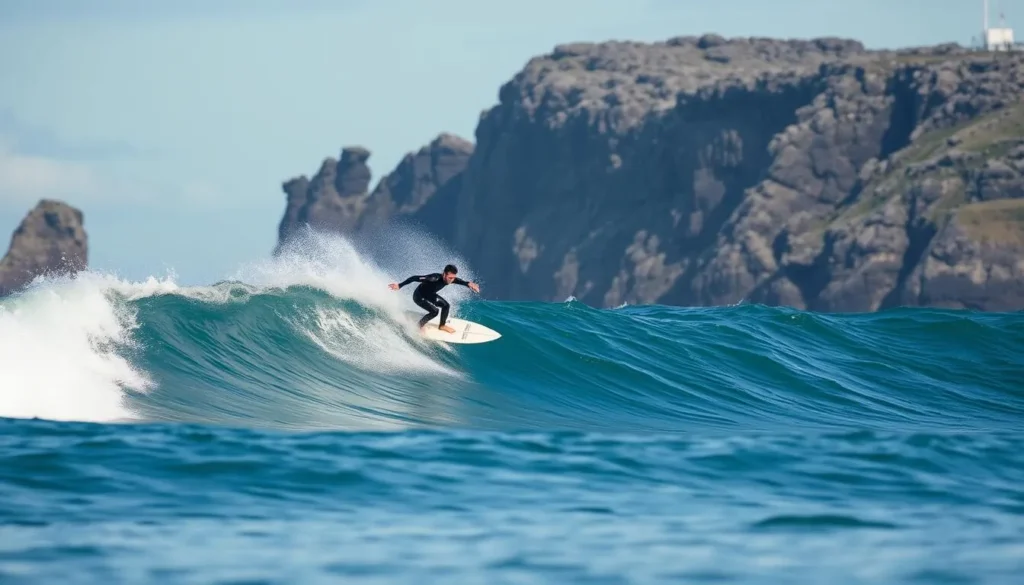
The Atlantic beaches of Lewis and Harris offer excellent surfing conditions
Water Sports
The Atlantic-facing beaches of Lewis and Harris offer excellent conditions for surfing, windsurfing, and kitesurfing. Dalmore Beach on Lewis and Scarista on Harris are popular spots for catching waves. For kayaking and stand-up paddleboarding, the more sheltered east coast provides calmer waters perfect for beginners. Equipment rental and lessons are available from Isle of Harris Outdoor Centre.
Hiking and Walking
The diverse landscapes of the Outer Hebrides provide walking opportunities for all abilities. Challenge yourself with a climb up Clisham (the highest peak in the Outer Hebrides at 799m) for panoramic views across Harris, or enjoy gentle coastal walks along the countless beaches. The Hebridean Way walking route spans the entire archipelago over 156 miles, which you can tackle in sections.
Wildlife Watching
The Outer Hebrides host impressive wildlife both on land and at sea. Join a boat tour from Stornoway or Leverburgh to spot whales, dolphins, porpoises, and basking sharks. Birdwatchers should visit the RSPB reserves at Balranald (North Uist) and Loch na Muilne (Lewis). Keep your eyes peeled for majestic white-tailed sea eagles, which have been successfully reintroduced to the islands.

The majestic white-tailed sea eagle has been successfully reintroduced to the Outer Hebrides
Fishing
With countless freshwater lochs and miles of coastline, the Outer Hebrides offer world-class fishing opportunities. The islands are renowned for salmon and trout fishing, with permits available for various lochs. Sea angling is also popular, with mackerel, pollock, and even shark possible catches. Local guides can provide equipment and take you to the best spots.
Cultural Experiences and Local Life
Gaelic Language and Music
The Outer Hebrides remain a stronghold of Scottish Gaelic language and culture. Over 60% of islanders speak Gaelic, and you’ll hear it used in everyday conversation. Learn a few basic phrases like “Madainn mhath” (Good morning) and “Tapadh leat” (Thank you) to connect with locals. Traditional music thrives here – check local pubs for ceilidhs (traditional Scottish gatherings with music and dancing) and live music sessions.
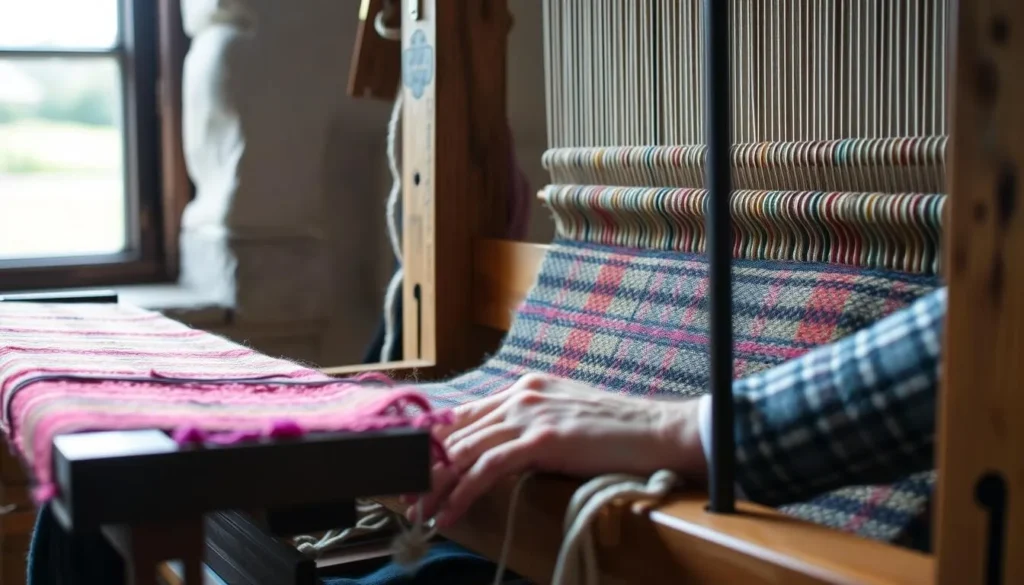
Harris Tweed weavers continue the centuries-old tradition of handweaving this famous fabric
Traditional Crafts
Beyond Harris Tweed, the islands support a thriving community of artisans creating pottery, jewelry, art, and knitwear. Visit studios along the Hebrides Art Trail to meet makers and purchase unique handcrafted souvenirs directly from the creators. Many draw inspiration from the islands’ landscapes, creating pieces that capture the essence of the Hebrides.
Local Cuisine
Seafood is the star of Hebridean cuisine, with fresh catches including lobster, crab, scallops, and various fish. Traditional dishes include Stornoway Black Pudding (protected by geographical indication status), hearty soups like Scotch broth, and baking traditions such as oatcakes and shortbread. For an authentic taste, try the seafood platters at The Anchorage in Leverburgh or sample local produce at the Stornoway Smokehouse.
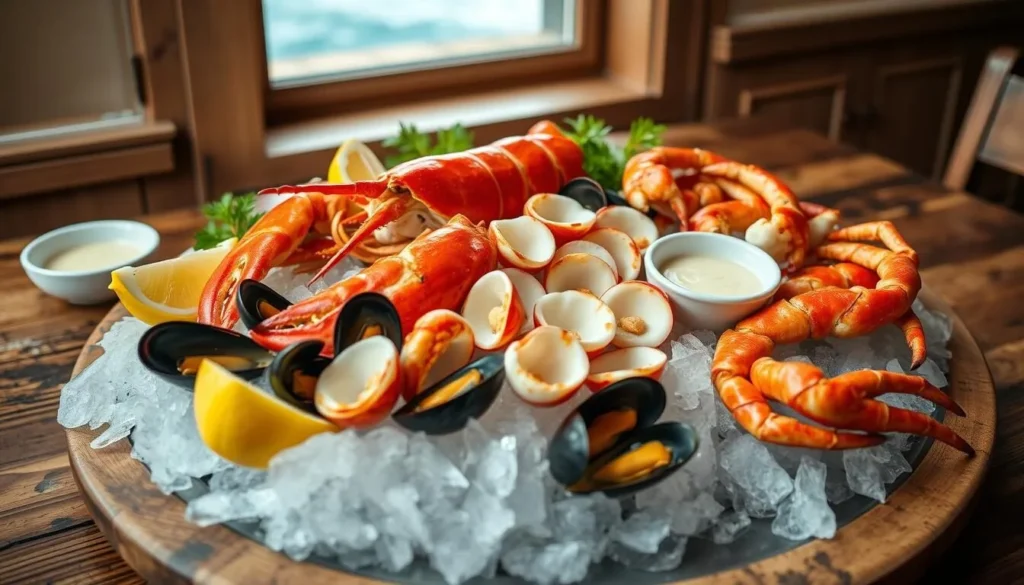
Fresh seafood is a highlight of Outer Hebrides cuisine
Practical Tips for Visiting the Outer Hebrides
Weather Preparedness
The Hebridean weather can change rapidly. Pack layers, waterproof clothing, and sturdy footwear regardless of when you visit. Even summer days can be windy and showery, though they can also be surprisingly warm and sunny. The saying “four seasons in one day” often applies here!
Cash and Banking
While larger establishments accept cards, smaller shops, cafes, and markets in remote areas may be cash-only. ATMs are available in Stornoway, Tarbert, and larger villages, but can be scarce elsewhere. Bring sufficient cash for daily expenses, especially when exploring remote areas.
Mobile Coverage
Mobile phone coverage has improved but remains patchy in remote areas. Download offline maps and save important information before traveling to areas with limited connectivity. Most accommodations offer Wi-Fi, though connection speeds may be slower than you’re accustomed to.
Midges
These tiny biting insects can be a nuisance during calm, damp evenings from late May to September. Bring insect repellent containing DEET or Picaridin, and consider a midge net for your head if you’re particularly sensitive. The good news is that the islands’ frequent breezes often keep midges at bay.
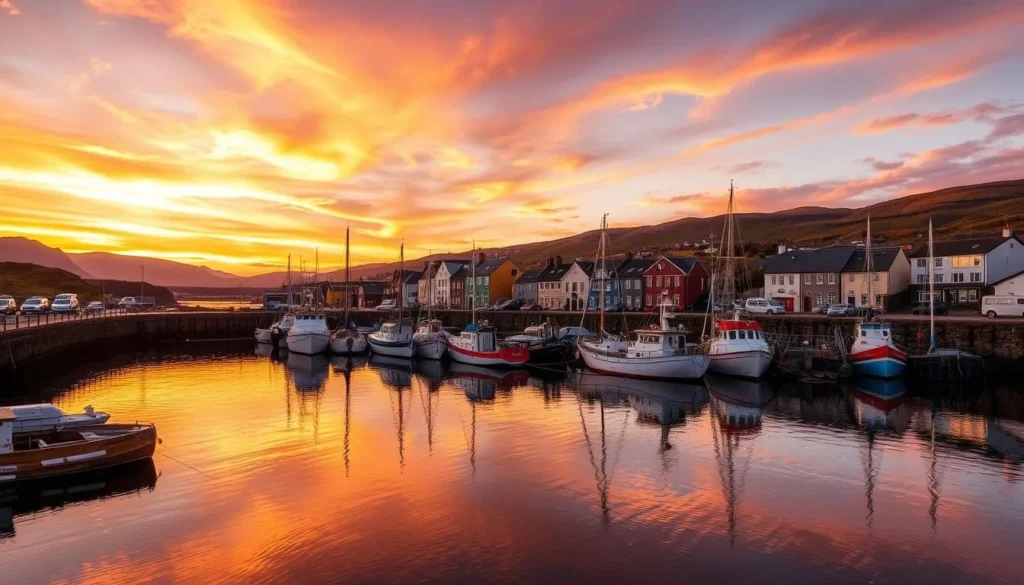
Stornoway Harbor is the main port and largest settlement in the Outer Hebrides
Tidal Awareness: Many beaches in the Outer Hebrides experience significant tidal ranges. Always check tide times before walking on beaches or crossing to tidal islands. The local tourist information centers can provide tide tables, or use a tide prediction app.
Plan your Outer Hebrides adventure
Book accommodation, transportation, and activities in one place for a seamless island experience.
Browse Activities
Why the Outer Hebrides Should Be Your Next Destination
The Outer Hebrides offer a rare combination of pristine natural beauty, ancient history, and living cultural traditions that few destinations can match. From standing in the footsteps of Neolithic ancestors at Callanish to feeling the soft white sand of Luskentyre between your toes, these islands provide experiences that linger in memory long after you’ve returned home.
What makes the Outer Hebrides truly special is their remoteness and authenticity. Here, you’ll find communities living in harmony with their environment, maintaining traditions while embracing visitors with genuine warmth. The pace of life invites you to slow down, breathe deeply, and connect with both nature and yourself.
With 15,000 archaeological sites waiting to be explored and seas that shift from emerald to sapphire by the hour, the Outer Hebrides demand to be experienced before everyone else discovers your new favorite escape. The journey may require some effort, but like all the best adventures, the rewards are immeasurable.
The above is subject to change.
Check back often to TRAVEL.COM for the latest travel tips and deals.
